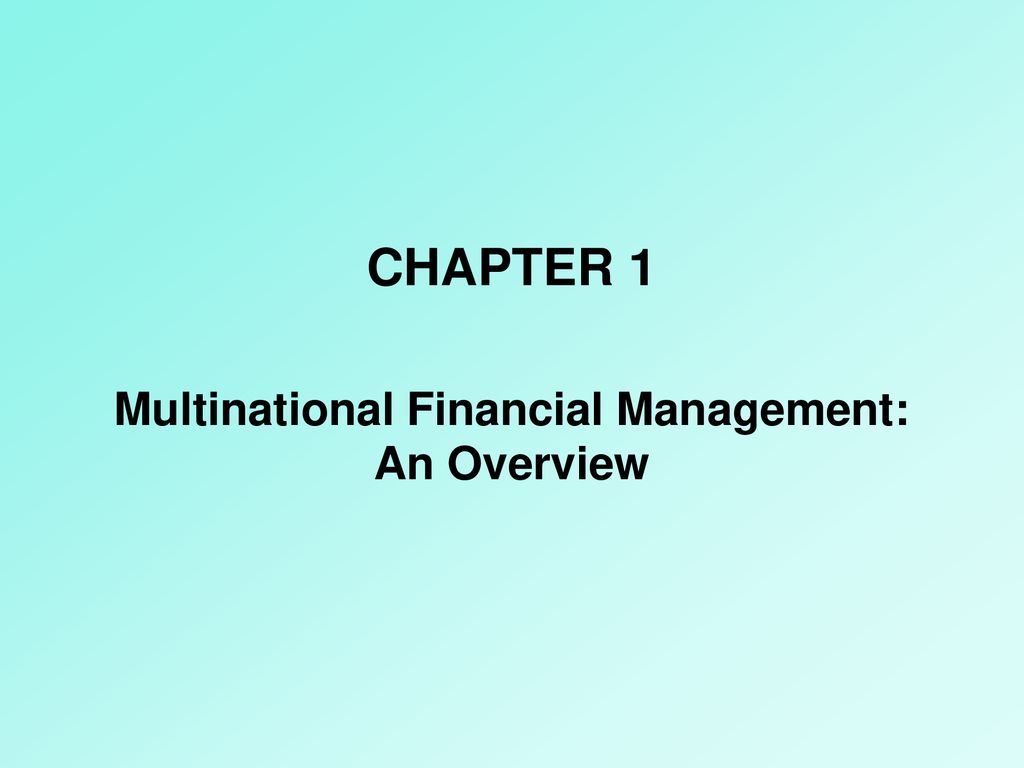Introduction
Chapter 1 multinational financial management an overview – In today’s globalized economy, multinational financial management has become increasingly significant. Multinational corporations (MNCs) face unique challenges and opportunities in managing their finances across borders, making it crucial for them to adopt effective financial strategies.
The challenges faced by MNCs include exchange rate fluctuations, political and economic risks, and complex tax regulations. However, they also have opportunities to access new markets, diversify their operations, and optimize their financial performance.
The Global Financial Environment
Exchange Rate Regimes
Exchange rate regimes determine the relationship between currencies and can significantly impact MNCs’ financial management. The different types of exchange rate regimes include fixed, floating, and managed float regimes.
Fixed exchange rate regimes peg the value of a currency to another currency or a basket of currencies, while floating exchange rate regimes allow the value of a currency to fluctuate freely based on market forces. Managed float regimes fall somewhere in between, allowing for some flexibility while maintaining a degree of stability.
International Financial Institutions
International financial institutions, such as the International Monetary Fund (IMF) and the World Bank, play a vital role in facilitating global financial transactions. They provide loans, technical assistance, and policy advice to countries and businesses, helping to stabilize the global financial system.
Political and Economic Risks
MNCs operating in foreign countries are exposed to political and economic risks that can affect their financial performance. These risks include political instability, economic downturns, and changes in government policies.
Foreign Exchange Management: Chapter 1 Multinational Financial Management An Overview
Foreign Exchange Risk, Chapter 1 multinational financial management an overview

Foreign exchange risk arises when the value of one currency fluctuates against another. This can impact MNCs’ revenue, expenses, and profits. The different types of foreign exchange risk include transaction risk, translation risk, and economic risk.
Hedging Foreign Exchange Risk
MNCs can use various methods to hedge foreign exchange risk, including forward contracts, options, and swaps. Forward contracts lock in an exchange rate for a future transaction, while options give the holder the right, but not the obligation, to buy or sell a currency at a specified price on a specified date.
Swaps involve exchanging cash flows in one currency for another currency at a predetermined exchange rate. MNCs can also use natural hedging techniques, such as matching their foreign currency assets and liabilities, to reduce their exposure to foreign exchange risk.
Outcome Summary
In conclusion, Chapter 1: Multinational Financial Management: A Comprehensive Overview provides a comprehensive foundation for understanding the complexities and dynamics of managing finances in a globalized economy. It emphasizes the importance of strategic financial planning, risk management, and ethical considerations for multinational corporations seeking to succeed in the international arena.
By embracing a holistic approach to multinational financial management, businesses can harness the opportunities and mitigate the challenges of operating in a globalized world.
Essential Questionnaire
What are the key challenges faced by multinational corporations in managing their finances?
Multinational corporations face various challenges in managing their finances, including foreign exchange risk, political and economic risks, regulatory compliance, and cultural differences.
How can multinational corporations manage foreign exchange risk?
Multinational corporations can manage foreign exchange risk through various methods, such as forward contracts, options, swaps, and natural hedging.
What are the different types of international investment?
The main types of international investment include foreign direct investment (FDI) and portfolio investment.
How do multinational corporations finance their global operations?
Multinational corporations can finance their global operations through various sources, including equity, debt, and hybrid financing.
What are the ethical and social responsibilities of multinational corporations in managing their finances?
Multinational corporations have ethical and social responsibilities to consider in managing their finances, including minimizing their environmental impact, respecting human rights, and contributing to local communities.